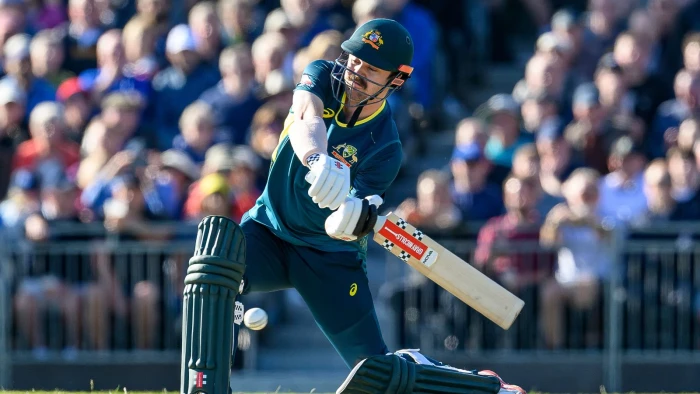16 conclusions from England's stunning second Test victory at Trent Bridge

Jonny Bairstow celebrates his century at Trent Bridge in the 2nd Test
The dust has settled on another fascinating Test match between England and New Zealand. Dave Tickner looks back at what we learned from the Trent Bridge epic.
Jonny Bairstow's stunning 136 from just 92 balls and Ben Stokes' unbeaten 75 led England to an incredible five wicket victory, and with it an unassailable 2-0 lead in the three game series.
The impact of new head coach Brendon McCullum was already being felt after the first Test, but his stamp on Trent Bridge can't be understated either. There's so much to unpick.
What a ridiculous game of cricket
It almost defies description and analysis, which is a problem when you've got to write 16 pieces of description and analysis about it because someone once did so about a football game on Football365 for a laugh and now you're stuck with the format apparently forever.
That match was a huge shot in the arm for Test cricket everywhere.
It doesn't matter where exactly you sit on the "Test cricket is dying!" panic - the sky has been falling in for Test cricket almost as long as it has been around, and it's still here the mad old time-consuming bastard - to realise that games like this, with atmospheres like this, in front of crowds like this can only help the longest form.
This is now one of those matches that joins the likes of Edgbaston '05 and Headingley '81 or '19 in the consciousness. It is a game that will be brought up every time there is third-innings declaration speculation in every match England play from now until the seas rise and claim us all.
Five-wicket win is a footnote
Just as at Lord's, the game ends in a five-wicket win for England. Just as at Lord's, this tells but a fraction of the story.
That a chase of 300 never felt daunting even with Joe Root back in the sheds for a handful really is quite something.
That Stokes' instructions to Bairstow - "don't keep it down, put it in the back of the stands" - had clear echoes of Eoin Morgan's "smash the lights out" was neither coincidence nor accident is also undeniable.
One advantage for this revolution is that some absolutely key players - Stokes, Bairstow, Root - have already been through one such transformation.
Red Ball Reset
England's Great Red Ball Reset has another crucial similarity to the White Ball Reset of 2015. That journey would end, memorably, with a barest-of-margins victory against New Zealand at Lord's in the 2019 World Cup final.
But it also began against a New Zealand side led by Brendon McCullum.
They had just lost the World Cup final to Australia in a tournament where England had crashed out in the group stage. Yet when England came along playing nonsense cricket and smashing the ball all around the country instead of trying to get 250 and hope it was enough, McCullum's New Zealand went "Sure, we'll play along".
What we do know is that the Red Ball Reset has started exactly the same way.
Thrilling cricket from England, this time with McCullum in their corner, against a New Zealand side that might have expected to beat an England side on the back of a string of drab and embarrassing defeats but that has, when faced with something new and exciting, decided to play a full part in running with it even if that might not be prudent.
The best of Bairstow
So, Jonny Bairstow, then. Absolutely extraordinary.
The numbers of it are pure daft. He got to his hundred from 77 balls. He scored his last 92 runs post-tea in 44 balls.
The fastest ever Test century scored by an England batter when we don't have to rely on a journalist from the time saying "Yeah, it was 76 balls that" which is genuinely how Gilbert Jessop holds the record for what was undoubtedly, no matter how many balls it actually took, an extraordinary innings in a one-wicket win in 1902.
Rightly or wrongly, the only England batter to make Test centuries in both West Indies and Australia this winter came into that innings with not only the team to think about but also once again his own place in the side.
Every boundary from one of our greatest Test innings of all-time ??
— England Cricket (@englandcricket) June 15, 2022
??????? #ENGvNZ ?? | @jbairstow21 pic.twitter.com/ekzhhPVgn7
Stokes not the hero for a change
Even in an ODI - and like everyone else we enjoyed England chasing down their 299-run target in 50 overs - it's pretty unusual to have a run-a-ball 75 not out relegated to support act status.
That is HUGE!
— England Cricket (@englandcricket) June 14, 2022
Scorecard & Videos: https://t.co/ffFnHnaIPX
??????? #ENGvNZ ?? pic.twitter.com/f8zD3yeqBs
The Mitchell and Blundell partnership
At that point Daryl Mitchell and Tom Blundell were doing a passable impression of their own partnership from the second innings at Lord's.
A lot has happened since that partnership on days one and two but it was still extraordinarily good, not least for being a back-to-back effort from two of New Zealand's less heralded players.
Given New Zealand are a team of unheralded players - they are literally world champions remember - that's kind of on-brand, I guess. It wasn't just a massive partnership but also a crucial one.
On a flat pitch and fast-scoring ground, New Zealand had just got themselves in a touch of bother at 169-4 having twice lost a pair of wickets in quick succession.
In any sane match, what Mitchell and Blundell did over the ensuing 58 overs and 236 runs should have been a) enough to ensure New Zealand couldn't lose and also b) eye-catchingly fast. Turns out neither of those things were in any way true, but it was still remarkable.
Joe Root century
Let's continue rattling through those dull first innings when not much happened, yeah. Get back to talking about day five soon.
This was his 10th Test century in the last year and a half - enough to constitute a pretty decent career on its own - and also his fastest.
He scored at five an over pretty much throughout and even ended up playing reverse-paddles for six off Tim Southee less than a week after Geoffrey Boycott had spoken admiringly about how Root doesn't do things like that because he plays "proper cricket".
A quiet start to the morning in Nottingham...
— England Cricket (@englandcricket) June 13, 2022
Scorecard & Videos: https://t.co/GJPwJC59J7
??????? #ENGvNZ ?? pic.twitter.com/Fjz96fl2SZ
In just his second match at number three - and that's second first-class match, not just second Test match - he played beautifully.
England have had false dawns before, but if Pope can bat this well in that position and actually nail that spot down then it has an incalculable impact on England's batting woes.
Not least in allowing Root to just crack on breaking all manner of records from his favoured spot at four.
He's a great team man is Root, and there is no reason whatsoever to doubt his enthusiastic celebration of Pope's hundred was entirely genuine, but there must have been the tiniest bit of his brain thinking what good news it was for him as well.
Another James Anderson milestone
A word on James Anderson, who continues to be extraordinary. Went past 650 Test wickets this week, a number that boggles the mind.
Even if he doesn't quite get to 700 he now looks certain to end up 100 past Glenn McGrath's 563 which is hard to compute.
Anderson also now has 383 Test wickets since turning 30; that's the same number as Ian Botham managed in his entire career.
The perfect start and Test wicket number 6️⃣5️⃣0️⃣ for @jimmy9 ?
— England Cricket (@englandcricket) June 13, 2022
Scorecard & Videos: https://t.co/GJPwJC59J7
??????? #ENGvNZ ?? pic.twitter.com/PLFNZU6P2k
Trent Boult with the ball
And if we're bringing up Anderson's impressive figures in a match dominated so thoroughly by the bat, then it's only right to do likewise with Trent Boult.
Trent Boult with the bat
But let's be real, the best thing about Trent Boult isn't his bowling, it's his batting.
While he may be more of an Anderson with the ball, he's at least as entertaining as Broad with the bat.
He plays shots nobody else could even think of and does it all while providing his own ball-by-ball commentary and - crucially - generally getting out before it all stops being funny and just starts being bone-achingly dull.
Tim Southee nightmare
Yet while Boult had one of his very best games, his old buddy Tim Southee had a desperate, torrid struggle.
Sometimes it just really isn't your game.
And he didn't even manage any of his customary fun with the bat against England either, making just four in the first innings before having the lid put firmly on his match by being run out without scoring in the second after being sold an absolute dummy by Daryl Mitchell who, on the evidence of this match, has only that one flaw to eliminate from his batting now.
Woeful catching
All the bowlers in this game - those who struggled and those who very much didn't - could point to the standard of catching with some justified grumpiness.
England's top order finally clicking?
Six of England's top seven have now made at least one half-century in this series now thanks to Bairstow's belated and half-decent contribution.
Any thoughts that he might be replaced for Headingley were ended by England's victory here. But you'd imagine a spot at Edgbaston the following week against India - England really do play a lot of cricket, don't they? - will require runs in Leeds.
Lees is a good example of how a positive approach doesn't mean a one-size-fits-all approach.
It doesn't require everyone to bat like Bairstow or Stokes or Root - which is just as well because few can - but just to be the best and most positive version of themselves.
Silly old Trent Bridge
While we bathe in the aftermath of an astonishing day to end an astonishing Test as records tumbled, including for most boundaries ever in a Test match, it would be remiss not to address the fact that Trent Bridge - righteously beloved as it is by all for many, many reasons - is now a very, very silly cricket ground.
Change of mindset
Which also brings us to another point. There is an obvious and to some extent valid comparison to make between this game and the Lord's Test between these sides last year, when England rejected the chance to pursue a target of 273 in 70 overs.
Final day freebie
Having had a churlish pop at Trent Bridge for the shape of their ground it's only right to end on a celebration of the entertainment they hosted and the part they played in it.
Clearly, they couldn't have known quite how good it was going to be, but it was always going to be decent.
It was never going to be a short day's play and it was never going to be one where anyone would feel robbed if they'd spent 20 quid on the privilege.
Test Match Special's Phil Tufnell spent some time with the crowd and spoke to people attending for the first time or returning after years away.
Over the last couple of Covid-afflicted years we've heard a lot of talk from sports clubs and organisations about how important fans are and how it means nothing without them.
The top ten moments from a simply incredible Test match ? ??????? #ENGvNZ ?? pic.twitter.com/BttnT6qMMC
— England Cricket (@englandcricket) June 15, 2022



